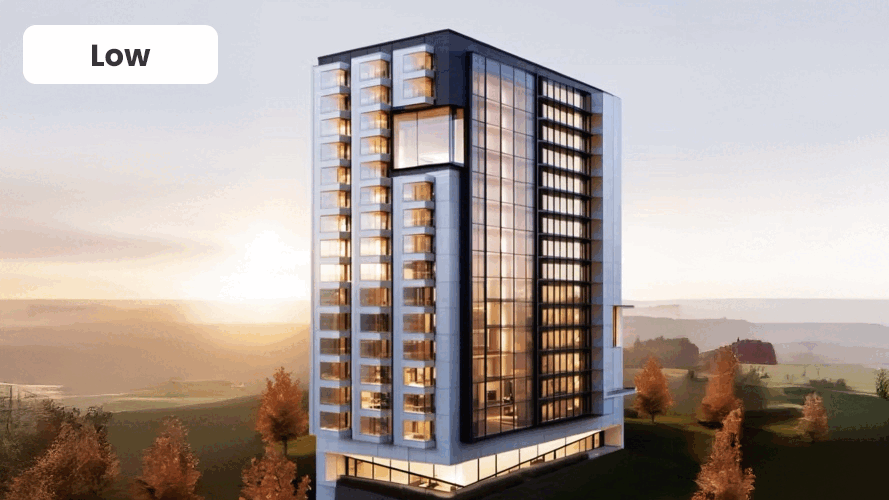
Geometry Override
Find the perfect balance between creativity and precision. Increase the slider for limitless ideation, pushing beyond model constraints. Lower it for strict geometry adherence while still refining materials.



Quickly generate and refine visual concepts, all within your favorite CAD tools.
Veras is an AI-powered visualization tool that helps architects and designers to quickly generate and refine visual concepts directly within design software like Revit, Rhino, SketchUp and others. Using generative AI it transforms sketches, 2D images and 3D models into realistic renderings and animations enabling rapid style, material, and design exploration.

Find the perfect balance between creativity and precision. Increase the slider for limitless ideation, pushing beyond model constraints. Lower it for strict geometry adherence while still refining materials.

Perfect every detail of your images like never before. Be in full control of your visual narrative refining details in real time. Select any part of your image, apply a new prompt, and render instantly.

Whether refining architecture, fine-tuning projects, or exploring design variations, iterate with precision and unlock endless possibilities. Revisit your creative journey using the same seed while applying a new prompt for a perfect blend of consistency and creativity.

Veras is also available as a web application. Enjoy creative freedom with Image-to-Image—no BIM software or installations needed. Simply upload your image or sketch and access all the powerful tools you love.
Designers first. Chaos is committed to developing AI that empowers creators, enhances workflows, and supports the creative process with trust and transparency at the core.




 Sonnentag Architektur
Sonnentag ArchitekturSee how Sonnentag Architektur used Enscape and Veras to design a flexible, inviting healthcare facility that impressed clients and anticipates long-term needs.
 Marco Iannelli
Marco IannelliLearn how architect Marco Iannelli harnessed the power of Veras and Enscape when designing the sustainable rooftop extension for the multi-family residence.
The Veras Basic Tier in Enscape Premium provides access to standard GPU cloud infrastructure with a limit of 100 videos per month, while the Veras Pro Tier in the ArchDesign Collection provides access to high-end GPU cloud infrastructure with a limit of 250 videos per month. The Veras Standalone includes the creation of up to 250 videos per month.
Learn more >


According to the U.S. Copyright Office, AI-generated content can be copyrighted when a human contributes to or meaningfully edits the image: Read the official guidance here. Veras uses your 3D model and camera view as the visual foundation ("substrate") for rendering, meaning the output is directly based on your authored content. You're also providing human input through prompt creation, seed locking, and render selection—making the process co-authored. These human input components, inherent in the use of Veras, firmly align any output with the copyrightable content requirements of the United States Copyright Office guidance.
In the EU, the focus is more on the originality of the work. Different countries may apply slightly different thresholds for what qualifies as sufficient human input or creative originality. So while human involvement is key, the exact legal treatment may differ from country to country.
We can assure you that Chaos does not claim ownership to the outputs you create using Veras. However, we may retain certain limited rights to use those outputs — primarily to operate and improve our products and services. Additionally, we may impose certain limitations on the use of our products, services, and content (for example, prohibiting uses that violate applicable law or that involve creating physical embodiments of our proprietary content). You can find the exact wording in our License and Services Agreement.
Your rights to the outputs will depend on several factors, particularly the context in which the rendering was created (e.g., whether independently, as part of your employment, or under a client contract), as well as any third-party rights in the underlying model or assets used.
Veras is powered by Stable Diffusion, which is trained on the LAION dataset, a large-scale, publicly available image-text dataset compiled from internet sources.
No. The output generated by Veras is not a reproduction of any single training image. The model generates entirely new content based on the structure of your 3D design and your textual guidance. As long as the input is yours, the output is yours.
Veras sends only essential data (camera view and geometry snapshot) to the cloud for rendering.
Yes. The number of videos you can render depends on the Veras tier included in your suite:
| Feature | Basic tier (Enscape Premium) | Pro tier (ArchDesign Collection) |
|---|---|---|
| GPU type | Standard GPU | High-end GPU |
| Queue times | Few seconds to several minutes | Instant to a few seconds |
| Parallel renderings | Up to 4 | Up to 8 |
| Number of videos | 100 | 250 |
